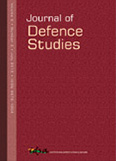The People Next Door: The Curious History of India’s Relations with Pakistan, by T.C.A. Raghavan
‘The People Next Door’ is the name of a 1968 television (TV) series made into a 1970 Hollywood movie, a 1996 TV film, a 2008 novel, again a 2016 TV film, and, in the case of the book being reviewed, a non-fiction historical book. When we spend time in observing neighbours, the act has a voyeuristic feel.
- Ghanshyam Katoch |
- October-December 2018 |
- Journal of Defence Studies





